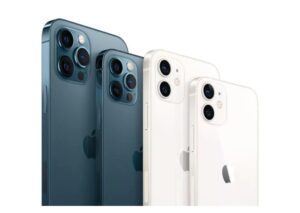iPhone 12’s price tag could be more important for Apple’s success story
This year, Apple introduced four iPhones, ranging from the iPhone 12 Mini to the iPhone 12 Pro Max.

Apple’s next-generation iPhones are facing challenges far beyond Samsung, Motorola and Google. Apple’s iPhone 12 family hits the market at an extraordinary time — with the coronavirus pandemic leaving tens of millions of people out of jobs and kicking off a recession that has thrown everything into a state of uncertainty. The new phones feature a boxier look, a magnetic attachment called MagSafe and, yes, super-fast 5G, but the price tag of these typically premium gadgets may be more important than ever.
Rivals have already responded to the economic and health crisis. Samsung unveiled the Galaxy S20 FE, a budget phone with high-end specs wrapped in a plastic housing that helps push its price down to $700 from the $1,000 price tag for its standard cousin. Google cut the price of its flagship Pixel 5 by $100 from the previous year’s model to $699.
On Tuesday, Apple announced its $699 iPhone 12 Mini, a handset the company says is the smallest 5G phone in the world. The Mini is nearly identical to the iPhone 12, only with a 5.4-inch screen, compared to the larger one’s 6.1-inch screen. Both have the same new, sharper screen technology, “ceramic shield” screen protector system, faster A14 Bionic processing chip, and the new MagSafe charging and accessories system.
A smaller phone for the same price may come across as a price hike, which is likely why Verizon and Apple are offering that people can turn in phones as old as 2017’s iPhone X and buy the $699 iPhone 12 Mini for $288 over 24 months, and its larger $799 iPhone 12 cousin for $320 over 24 months.
“This is an unprecedented leap forward for iPhone,” said Kaiann Drance, Apple’s vice president of iPhone product marketing. She especially called out the Mini, saying “we think this will be an incredibly popular iPhone.”
Apple watchers are expecting the $699 iPhone 12 Mini (£699, AU$1,199), along with the $799 iPhone 12 (£799, AU$1,349), $999 iPhone 12 Pro (£999, AU$1,699) and $1,099 iPhone 12 Pro Max (£1,099, AU$1,849) will offer the right mix of new boxier designs and upgraded 5G wireless to kick off a super cycle of buying not seen since the iPhone 6 was released in 2014. Back then, it pushed Apple’s holiday sales to 74.5 million units, up more than 45% from the 51 million it sold during the same period in 2014. Apple’s holiday iPhone sales haven’t budged much ever since.
For Apple, the lingering question is whether all that will be enough to kick off the “super cycle” of purchases that analysts expect to follow the hype that comes from a new design and upgraded 5G wireless technology. And whether the price will be justified.
Apple’s big swing
Apple’s events have a predictable cycle to them, with leaks and hype buildup beforehand, tons of attention during the event and then the post-announcement letdown. Questions start pouring in: Did Apple change enough? Did it screw up by not including a specific technology? Did it push too hard removing this or that feature? What about those Samsung phones?
Each time, Apple’s largely put those questions and concerns to rest. Although iPhone sales growth has largely hit a ceiling since the iPhone 6 in 2014, they haven’t fallen off a cliff either.
With the novel coronavirus still spreading around the world, Apple’s widened its array of iPhones to offer devices for as low as the $399 iPhone SE, with last year’s processing chip and the iPhone 6-inspired design, up to the $1,099 iPhone 12 Pro Max. Apple will also continue selling last year’s entry-level iPhone 11 for $599, which is $100 off the original price.
“While iPhone SE remains the lineup value leader, Mini provides a 5G value offering that retains key elements of the 12 lineup,” said Ross Rubin, an analyst at Reticle Research. He added that he expects the iPhone 12 Mini to be a standout hit.
Uncertain future
Though Apple is facing a bumpy economic environment, it doesn’t appear to be letting up on features for the sake of cost. The newly hardened glass screens, MagSafe charging and accessories technology, and advanced cameras are the latest ways Apple is hoping to compete against its rivals.
It’s a trend Apple repeated last month. Then, Apple announced the revamped iPad Air, with many of the same features as the iPad Pro, including support for the Magic Keyboard cover and Apple Pencil, but starting at $599. That compares to the iPad Pro, which costs $749.
The company also announced a new $279 Apple Watch SE, which offers similar features to last year’s Apple Watch Series 5 without the added oxygen sensor and ECG app. This year’s new Apple Watch Series 6, by comparison, has faster chips, an always-on display and the aforementioned health features starting at $399.
That’s not to say Apple’s suddenly dropping prices. When the company on Tuesday also introduced its HomePod Mini, a smart speaker to compete against Amazon’s Echo and Google’s Nest Mini, it announced the price at $99. That’s twice the cost of an Amazon Echo or Google Nest Mini, both of which are often on sale as well. But Apple says its Siri voice assistant and new interactions that allow you to control and communicate with the iPhone, CarPlay and other systems make it worthwhile. It’s also much cheaper than the $299 HomePod, which debuted in 2018.
Discover more from Applygist Tech News
Subscribe to get the latest posts sent to your email.
